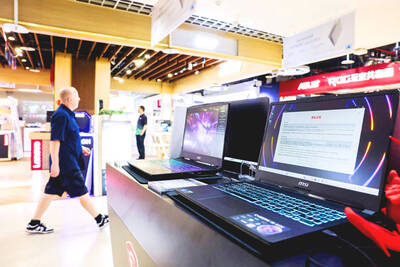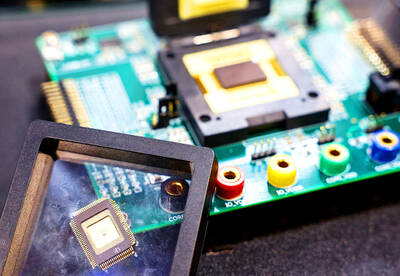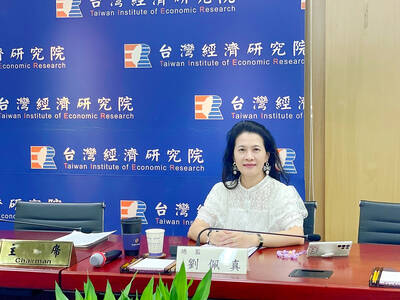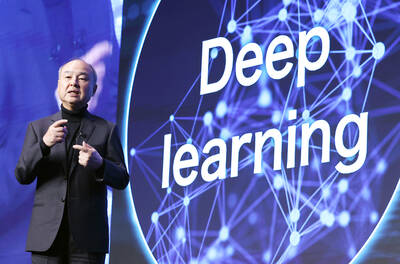Osaka Securities Exchange Co (OSE) yesterday rallied the most since August after the Nikkei Shimbun said Tokyo Stock Exchange Group Inc (TSE) has entered late-stage takeover talks to buy the operator of Japan’s second-largest equities market.
Osaka Securities rose 7.3 percent to end at ¥391,500 (US$5,012). Tokyo Stock Exchange, a privately held company that runs the main venue in the world’s third-largest equity market, would offer to buy as much as 66 percent of the Osaka bourse, Nikkei said.
TSE has made no decision like that reported yesterday, the exchange said in a statement. Osaka’s bourse has made no decision on a merger, it said in a separate statement.
TSE president Atsushi Saito in March began talking publicly about a merger between Japan’s largest two bourses. A marriage would give the 133-year-old Tokyo exchange, home to Sony Corp and Toyota Motor Corp, access to OSE’s derivatives trading system with Nikkei 225 Stock Average futures. It may also cut computer system costs for both companies.
“From the point of view of efficiency, it makes sense for the OSE and TSE to bring their respective strengths in derivatives and stocks to a merger,” said David DeGraw, a director in electronic trading services for Daiwa Securities Capital Markets Co in Tokyo. “A merger would reduce IT [information technology] costs in the long term if the exchanges decide on a unified trading platform.”
More than US$30 billion in exchange mergers have been proposed worldwide since October last year. Cross-border deals have met resistance from shareholders and regulators.
Australia blocked Singapore Exchange Ltd’s bid for ASX Ltd on national interest grounds. A shareholder-approved merger between NYSE Euronext and Deutsche Boerse AG faces an anti-trust complaint from the European Commission. The complaint says the combined company would monopolize derivatives trading, according to a person familiar with the matter.
London Stock Exchange’s offer for Toronto-based TMX Group Inc was withdrawn because too few owners supported it. TMX’s board last month endorsed a rival bid from a group of Canadian banks and pension funds that seeks to merge TMX with two domestic trading platforms.
“Exchanges are consolidating,” said Ichizo Yamauchi, principal executive officer at Tokyo-based Kokusai Asset Management Co. “In that context, a merger between Tokyo and Osaka is an inevitable development.”
Tokyo Stock Exchange is valued between US$1.89 billion and US$2.52 billion, 1.5 to 2 times more than Osaka, which had a market capitalization of ¥98.6 billion at the end of last week, the Nikkei said. Added to Osaka’s market capitalization as of Friday, the combined company would have a value of US$3.15 billion to US$3.78 billion, the data show. That’s more than Chicago-based Chicago Board Options Exchange at US$2.46 billion and smaller than London Stock Exchange at US$3.79 billion.
Overseas investors made 61 percent of the trades on Japan’s top three exchanges in the week ended Oct. 28, according to TSE data. The Nagoya Stock Exchange is the country’s third-biggest bourse.
“In the current set-up, intensifying competition in terms of pricing and liquidity means that foreign investors will be moving their orders to Hong Kong or Singapore,” Yamauchi said. “There’s the danger that Japan will become a local market.”

IN THE AIR: While most companies said they were committed to North American operations, some added that production and costs would depend on the outcome of a US trade probe Leading local contract electronics makers Wistron Corp (緯創), Quanta Computer Inc (廣達), Inventec Corp (英業達) and Compal Electronics Inc (仁寶) are to maintain their North American expansion plans, despite Washington’s 20 percent tariff on Taiwanese goods. Wistron said it has long maintained a presence in the US, while distributing production across Taiwan, North America, Southeast Asia and Europe. The company is in talks with customers to align capacity with their site preferences, a company official told the Taipei Times by telephone on Friday. The company is still in talks with clients over who would bear the tariff costs, with the outcome pending further

NEGOTIATIONS: Semiconductors play an outsized role in Taiwan’s industrial and economic development and are a major driver of the Taiwan-US trade imbalance With US President Donald Trump threatening to impose tariffs on semiconductors, Taiwan is expected to face a significant challenge, as information and communications technology (ICT) products account for more than 70 percent of its exports to the US, Chung-Hua Institution for Economic Research (CIER, 中華經濟研究院) president Lien Hsien-ming (連賢明) said on Friday. Compared with other countries, semiconductors play a disproportionately large role in Taiwan’s industrial and economic development, Lien said. As the sixth-largest contributor to the US trade deficit, Taiwan recorded a US$73.9 billion trade surplus with the US last year — up from US$47.8 billion in 2023 — driven by strong

A proposed 100 percent tariff on chip imports announced by US President Donald Trump could shift more of Taiwan’s semiconductor production overseas, a Taiwan Institute of Economic Research (TIER) researcher said yesterday. Trump’s tariff policy will accelerate the global semiconductor industry’s pace to establish roots in the US, leading to higher supply chain costs and ultimately raising prices of consumer electronics and creating uncertainty for future market demand, Arisa Liu (劉佩真) at the institute’s Taiwan Industry Economics Database said in a telephone interview. Trump’s move signals his intention to "restore the glory of the US semiconductor industry," Liu noted, saying that

AI: Softbank’s stake increases in Nvidia and TSMC reflect Masayoshi Son’s effort to gain a foothold in key nodes of the AI value chain, from chip design to data infrastructure Softbank Group Corp is building up stakes in Nvidia Corp and Taiwan Semiconductor Manufacturing Co (TSMC, 台積電), the latest reflection of founder Masayoshi Son’s focus on the tools and hardware underpinning artificial intelligence (AI). The Japanese technology investor raised its stake in Nvidia to about US$3 billion by the end of March, up from US$1 billion in the prior quarter, regulatory filings showed. It bought about US$330 million worth of TSMC shares and US$170 million in Oracle Corp, they showed. Softbank’s signature Vision Fund has also monetized almost US$2 billion of public and private assets in the first half of this year,